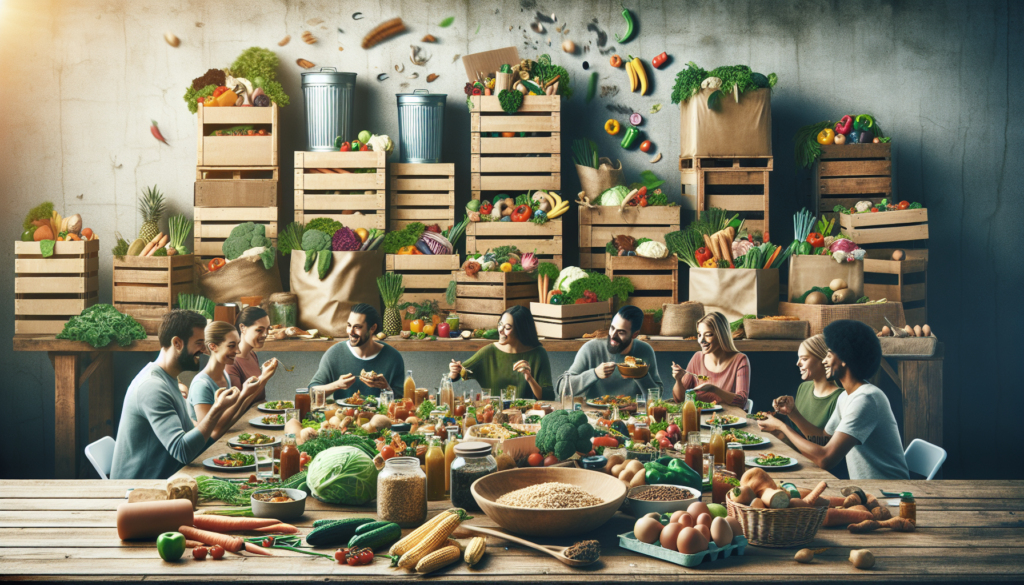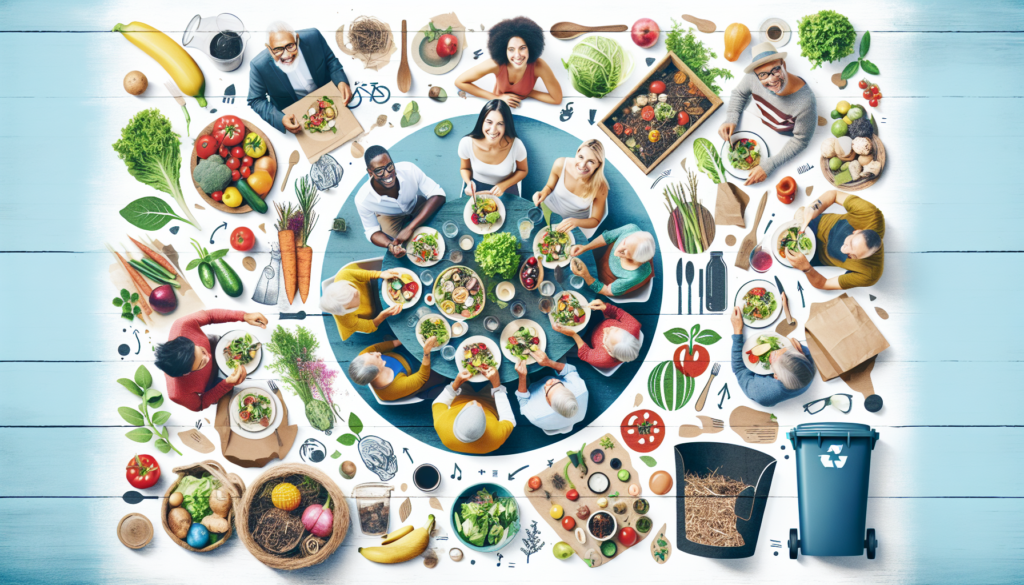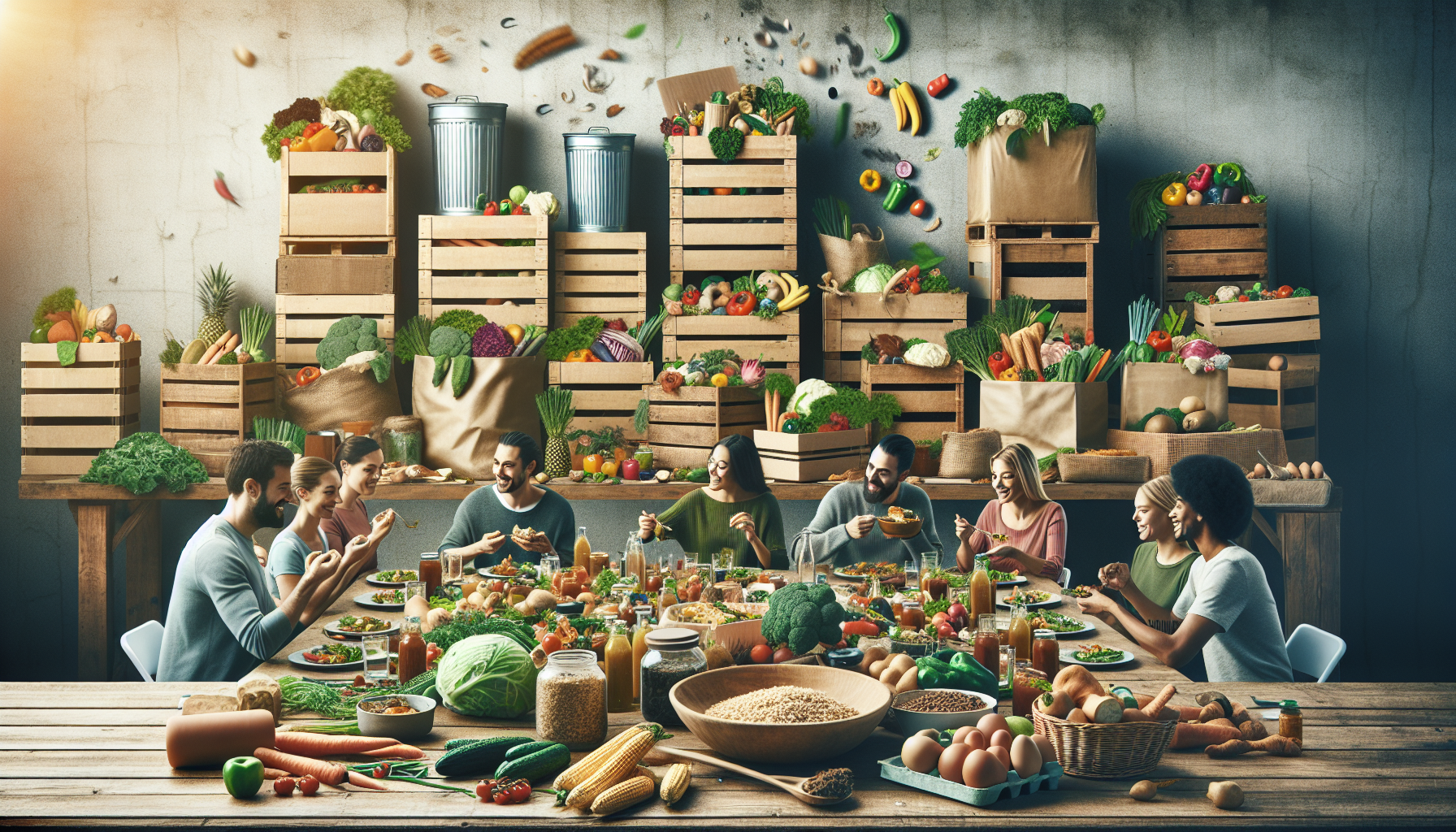Are you looking for simple yet impactful ways to reduce your carbon footprint and contribute to a healthier planet? Look no further! In this article, we will explore effective strategies to make your diet more eco-friendly. By making small changes to your eating habits, you can make a big difference in minimizing waste, conserving resources, and promoting sustainability. Get ready to discover practical tips and delicious alternatives that will not only benefit the environment but also improve your overall well-being. Let’s embark on this eco-friendly journey together!

Choosing Sustainable Protein Sources
Opt for plant-based proteins
One way to make your diet more eco-friendly is by choosing plant-based proteins. Plant-based proteins, such as legumes, nuts, and seeds, have a lower environmental impact compared to animal-based proteins. They require less land, water, and energy to produce, and they produce fewer greenhouse gas emissions. Additionally, plant-based proteins are often rich in fiber and various vitamins and minerals, making them a healthy choice for your diet.
Consume locally sourced meats
If you do consume meat, opting for locally sourced options can help reduce the carbon footprint associated with your food choices. Locally sourced meats typically travel shorter distances, reducing the emissions generated during transportation. By supporting local farmers, you also contribute to the local economy and help promote sustainable agricultural practices.
Choose sustainably caught seafood
When it comes to seafood, it’s essential to choose sustainably caught options to protect marine ecosystems. Look for certification labels like the Marine Stewardship Council (MSC) or the Aquaculture Stewardship Council (ASC) to ensure that the seafood you purchase is caught or farmed using environmentally responsible practices. Avoid species that are overfished or endangered, and consider consuming more plant-based seafood alternatives, such as seaweed or algae-based products.
Embracing Plant-Based Foods
Increase consumption of fruits and vegetables
Increasing your consumption of fruits and vegetables is not only beneficial for your health but also for the environment. Fruits and vegetables require fewer resources, such as water and land, to produce compared to animal-based products. They are also packed with essential nutrients, fiber, and antioxidants. Aim to include a variety of colorful fruits and vegetables in your diet to reap their health and environmental benefits.
Incorporate whole grains into your meals
Whole grains, such as quinoa, brown rice, and oats, are an excellent source of complex carbohydrates, fiber, and various nutrients. By incorporating more whole grains into your meals, you reduce your reliance on refined grains, which are often processed using more resources and contribute to higher greenhouse gas emissions. Whole grains can be a versatile addition to your diet and can be used in a wide range of dishes, from salads to soups and stir-fries.
Try legumes and pulses as protein sources
Legumes, including beans, lentils, and chickpeas, are not only rich in protein but also have a low environmental impact. They have nitrogen-fixing properties, which means they can enrich the soil with nitrogen, reducing the need for synthetic fertilizers. Legumes are also affordable and versatile, making them an excellent alternative to meat in various recipes, such as stews, curries, and burgers. Incorporating more legumes into your diet is a sustainable choice that benefits both your health and the planet.
Reducing Food Waste
Plan your meals and create shopping lists
Planning your meals and creating shopping lists can help reduce food waste. By knowing exactly what you need to buy and sticking to your list, you can avoid purchasing excess food that may end up going to waste. Take into account the number of people you are cooking for, consider portion sizes, and plan to use ingredients that can be versatile in different recipes to minimize waste.
Store food properly to extend its shelf life
Proper food storage is essential in preventing food from spoiling and going to waste. Invest in airtight containers and storage solutions that help maintain food freshness. Learn about the optimal storage conditions for different types of foods, such as keeping fruits and vegetables separate, storing leftovers promptly in the refrigerator, and utilizing the freezer for long-term storage. By storing food properly, you can extend its shelf life and reduce the amount of food that gets thrown away.
Reuse leftovers in creative and delicious ways
Leftovers often get overlooked and end up being thrown away. However, there are numerous creative ways to repurpose leftovers into new meals. Use leftover vegetables in soups, stews, or salads, and transform leftover proteins into sandwiches or wraps. Additionally, consider batch cooking and freezing leftovers for future meals. Reusing leftovers not only reduces food waste but also saves you time and money.
Buying Organic and Local Produce
Opt for organic fruits and vegetables
Choosing organic fruits and vegetables can have several environmental benefits. Organic farming practices avoid the use of synthetic pesticides and fertilizers, which can harm the environment and contribute to water pollution. Organic farms also prioritize soil health and biodiversity, promoting sustainable agricultural practices. Look for the USDA Organic label to ensure that the produce you purchase meets organic standards.
Support local farmers and markets
Supporting local farmers and markets is a great way to reduce the carbon footprint associated with food transportation. By purchasing locally grown produce, you support the local economy and help reduce the distance your food needs to travel to reach your plate. Additionally, local farmers often prioritize sustainable farming practices that promote soil health, water conservation, and biodiversity.
Consider joining a community-supported agriculture program
Community-supported agriculture (CSA) programs allow you to connect directly with local farmers and receive a variety of fresh, seasonal produce on a regular basis. By joining a CSA program, you support sustainable farming practices and reduce the environmental impact of your food choices. CSA programs often provide education about where and how your food is grown, fostering a connection between consumers and local agriculture.

Minimizing Packaging Waste
Purchase in bulk or choose products with minimal packaging
Buying in bulk or choosing products with minimal packaging can significantly reduce packaging waste. Look for stores that offer bulk bins where you can purchase items such as grains, legumes, nuts, and seeds using your reusable containers. When opting for packaged products, choose those with minimal packaging or opt for materials that are easily recyclable or compostable.
Bring reusable bags and containers when shopping
Bringing your own reusable bags and containers when shopping helps minimize the use of single-use plastic bags and packaging. Invest in sturdy, reusable grocery bags that you can keep in your car or carry with you. Additionally, bring your own containers for purchasing items from the deli or the bulk section. By doing so, you reduce the amount of plastic waste generated from your grocery shopping.
Avoid single-use plastic utensils and straws
Disposable plastic utensils and straws contribute significantly to plastic pollution, especially in the marine environment. Make a conscious effort to avoid using single-use plastic utensils and straws by carrying your own reusable options. Choose stainless steel or bamboo utensils and invest in a reusable straw made from materials like stainless steel or silicone. By making these small changes, you can help reduce plastic waste and protect the environment.
Optimizing Food Transportation
Choose local or regional food sources
Opting for local or regional food sources reduces the carbon footprint associated with long-distance transportation. When shopping, check for labels or inquire about the origin of the food to ensure it is locally or regionally produced. Supporting local food systems also promotes local economy and helps preserve local agriculture.
Reduce air miles by opting for seasonal produce
Seasonal produce is often grown locally or regionally, reducing the distance it needs to travel to reach your plate. By choosing seasonal fruits and vegetables, you can significantly reduce the carbon emissions associated with air transportation. Additionally, eating seasonally can introduce variety into your diet as different fruits and vegetables thrive during different seasons.
Support food delivery services that prioritize sustainability
If you rely on food delivery services, consider supporting those that prioritize sustainability. Look for companies that use eco-friendly packaging materials, promote local or sustainable food sources, and have efficient delivery systems to minimize fuel consumption. By choosing responsible food delivery options, you can reduce the environmental impact that can be associated with this convenient service.
Growing Your Own Food
Start a backyard garden or create a community garden
Growing your own food is one of the most sustainable ways to source fresh produce. If you have a backyard, consider starting a garden where you can grow your fruits, vegetables, and herbs. If space is limited, look for community garden initiatives in your area where you can rent a plot or join a collective effort to grow food together. By growing your own food, you reduce the need for transportation, packaging, and potentially harmful pesticides or fertilizers.
Utilize vertical gardening techniques for small spaces
Vertical gardening is an excellent solution for individuals with limited space, such as apartment dwellers. By utilizing walls or vertical structures, you can create a thriving garden without taking up much floor space. Install vertical garden systems or use hanging planters to grow herbs, leafy greens, and even small vegetables. Vertical gardening not only maximizes space efficiency but also adds a touch of greenery to your indoor or outdoor living areas.
Compost kitchen scraps to enrich the soil
Composting is a sustainable practice that helps reduce food waste and enriches the soil. Save your kitchen scraps, such as fruit and vegetable peels, coffee grounds, and eggshells, and create a composting system in your backyard. Composting provides valuable organic matter that can be used to nourish your garden. By composting, you divert organic waste from landfills and contribute to a healthier, more sustainable food cycle.
Making Sustainable Seafood Choices
Consult sustainable seafood guides
To make sustainable seafood choices, consult reputable seafood guides that provide information on which species are caught or farmed using environmentally responsible practices. These guides often consider factors such as the sustainability of fishing or farming methods, the population status of different species, and the impact on marine ecosystems. By following these guides, you can make informed decisions when purchasing seafood.
Avoid purchasing endangered or overfished species
To protect marine biodiversity and promote sustainable fishing practices, avoid purchasing endangered or overfished species. These species are at risk of depletion, which can have significant ecological consequences. Choose seafood options that are abundant and have sustainable fishing or farming practices. By opting for responsibly sourced seafood, you contribute to the preservation of marine ecosystems.
Consider farmed seafood options
When it comes to seafood, consider choosing farmed options that follow sustainable practices. Responsible aquaculture can reduce pressure on wild fish populations and minimize habitat destruction. Look for certification labels like the Aquaculture Stewardship Council (ASC) to ensure that farmed seafood meets environmental and social standards. By supporting responsible aquaculture, you help promote sustainable seafood production.
Minimizing Water Footprint
Conserve water while cooking and cleaning
Conserving water while cooking and cleaning is an important step in making your diet more eco-friendly. Simple practices such as using a basin to wash dishes instead of letting the water run, using a dishwasher only when it’s full, and steaming or boiling vegetables with minimal water can significantly reduce water usage. By being mindful of your water consumption in the kitchen, you contribute to water conservation efforts.
Choose foods that are less water-intensive
Some foods require more water to produce than others. As part of your eco-friendly diet, choose foods that are less water-intensive. For example, opt for grains like quinoa or millet instead of rice, as rice cultivation requires large amounts of water. Similarly, selecting plant-based proteins like lentils or chickpeas over meat and dairy products can help reduce your water footprint.
Opt for plant-based milk alternatives over dairy
Dairy production is notoriously water-intensive. By opting for plant-based milk alternatives, such as almond milk, oat milk, or soy milk, you can significantly reduce your water footprint. Plant-based milk alternatives require fewer resources to produce, including water, land, and energy. Moreover, they often have a lower carbon footprint and can be a delicious and nutritious substitute for dairy milk.
Supporting Sustainable Food Systems
Educate yourself on sustainable farming practices
To support sustainable food systems, it’s essential to educate yourself on sustainable farming practices. Learn about organic farming, agroecology, permaculture, and other sustainable agriculture methods. By understanding these practices, you can make informed choices, support farmers and producers who prioritize sustainability, and advocate for policies and practices that promote environmental stewardship.
Advocate for policies that promote sustainable agriculture
Advocacy is a powerful way to support sustainable agriculture and food systems. Stay informed about food-related policies and engage with your local representatives or organizations working towards promoting sustainable farming and food production. Voice your concerns and support policies that prioritize environmental sustainability, regenerative agriculture, and the protection of natural resources.
Support food companies committed to eco-friendly practices
When purchasing food products, consider supporting companies that are committed to eco-friendly practices. Look for certifications like the Fair Trade label, which ensures ethical labor practices and environmental standards, or the B Corporation certification, which recognizes companies that meet rigorous sustainability and social responsibility criteria. By supporting these companies, you contribute to a more sustainable marketplace and encourage others to follow suit.
In conclusion, making your diet more eco-friendly is not only beneficial for the environment but also for your health. By opting for plant-based proteins, consuming locally sourced and sustainably caught seafood, embracing plant-based foods, reducing food waste, buying organic and local produce, minimizing packaging waste, optimizing food transportation, growing your own food, making sustainable seafood choices, minimizing water footprint, and supporting sustainable food systems, you can play a significant role in creating a more sustainable and resilient food system. Making these changes may require some adjustments to your lifestyle and habits, but the collective impact of these choices can help preserve natural resources, protect biodiversity, and mitigate climate change. So, why not start today and make a positive difference through your diet?

